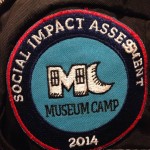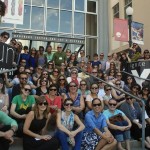This summer I was fortunate to attend Museum Camp 2014 at the Santa Cruz Museum of Art & History.
What is Museum Camp?
Museum Camp is an intense learning tool, modeled on traditional summer camps, for museum professionals. It serves as a model for challenging participants to do rather than to talk about making new connections in communities, with each year focused on a specific theme. This year’s theme was Social Impact Assessment and was co-facilitated by Nina Simon of the Santa Cruz Museum of Art and History and Ian Moss of Fractured Atlas.
A diverse range of professionals practicing in the arts, museums and social impact research world filled 100 available ‘camping spots’. Museum Camp is designed as an intense and immersive three-day camp that takes participants through a scarily fast process of ‘doing’ (rather than talking about) research design, implementation and reflection of a particular social impact.
The late nights and early mornings were set aside for opportunities for informal engagement such as ocean swimming, yoga, karaoke and butter aerobics – this is in California after all. They even allowed campers to sleep pretty much anywhere within the museum to keep costs down and to offer a fully immersive camp experience.
Participants were assigned to groups of four. Unfortunately, two members of our group weren’t able to participate so my partner Jason Tseng and I took on the work of the group. Fortunately, this actually made our work easier and allowed us to move through the process relatively quickly, especially since our styles meshed instantly. Covert strategies to get our research location of choice? Go Team Jerica!
We were mentored by Rebecca Ratzkin from Wolf Brown who posed thoughtful questions along the way to guide us to where we needed to be.
- Museum Camp’s co-facilitators and mentors.
- The Museum Camp Badge
Why is EHC interested in assessing social impact?
Those working in heritage today can’t ignore the need to be engaged and relevant organizations. If we don’t connect to our communities and aren’t relevant, why do we exist? Surely we’re meant to be more than a private club.
In the past two years, the Edmonton Heritage Council has begun to fully blossom as an organization and to live it’s mandate of ‘provid[ing] a forum for analyzing, discussing and sharing heritage issues in Edmonton, to advocate for a vibrant heritage community and heritage programs that benefit all Edmontonians’. As we grow into this, people we’ve met have begun to ask for our help in addressing incredibly complex social issues. How can EHC help reduce crime in the city? How can EHC help create healthy identities for youth through connection to their parents and grandparents?
These are scary questions because we don’t have the answers. However, we do know that we need to take these asks seriously. In order to be a vibrant, relevant and engaged organization that is tied to and reflective of its city, we must provide a space for these issues to be respectfully explored. Understanding the social impact of our current work will help us mindfully create the work of the future that will help us to work in partnership with our community to answer these tough questions.
I promise to write another blog specifically on the project we worked on, the lessons learned, and its connections to notions of risk-taking and rapid prototyping in a heritage context.
A huge thanks to Nina Simon, Ian Moss, Rebecca Ratzkin, MAH staff (MAH’ers) and other Museum Camp participants for an amazing learning experience!
The Edmonton Heritage Council appreciates the support of Canadian Heritage through the CMA Bursary Program to attend Museum Camp 2014
- Museum Camp group shot!


